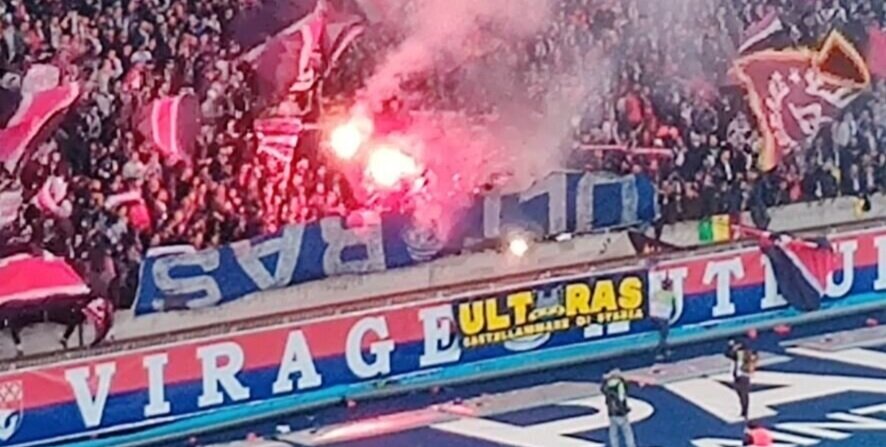Stealing Flags & Burning Scarves | A Fan Declaration of War
As noted in the book “Football, Violence & Social Identity” by Richard Giulianotti, Norman Bonney and Mike Hepworth, one of the ways in which a football fan group can show off their symbolic strength is by; “displaying courage to steal in front of all other fans the enemy’s flags, scarves or even hats is considered by the youngest ultras the noblest of group activities”.
It is all about the visual and tangible evidence of having a piece of the opposition in your possession that has you “one-up” on them. The theft, parade and sometimes destruction of these stolen goods has become a huge part of certain fixtures throughout world football, with this tit-for-tat war becoming a big part of certain fan cultures.
Flags, banners, scarves, jerseys, posters are all legitimate targets. When the particular fixture and fans in question only clash twice a season there is often a build-up of stolen “enemy” goods on display on match-day inside the stadium. After the declaration of war has been seen and these “prizes” have been displayed for all to see, what is left to do with them? Destroy and dispose of them.
Before we get into specific examples in the football world, it is worth noting that the symbolic desecration of a flag or banner can be viewed and enforced very differently in different parts of the world. In Algeria the desecration of the national flag is punishable with 5-10 years imprisonment. In Belgium it is not against the law to desecrate the national flag. While the USA has what is known as a “Flag Code” which carefully lays out the rules in relation to the national flag. For example, having the flag of the United States of America upside-down is prohibited, it symbolises dire distress (the upside-down aspect is worth noting for later on in the article).
A protester in Minneapolis flies the US flag upside-down during unrest in the city following the death of George Floyd | Photo Credit
Burning Scarves
So, armed with the knowledge that stealing or destroying a flag, banner or colours from an opposing fan may be a way to really get under their skin, ultras and hooligans around the world have treated this theft like a game.
Where better to start than with the ‘Holy War’ of Kraków. When Cracovia & Wisła Kraków square-off there is absolutely no love lost and to describe the relationship between the fans as “vicious” or “malicious” would not be an understatement. Such is the hate that all throughout the year fans on both sides are constantly on the look-out for enemy colours to steal and keep until derby day. The volume of stolen colours from opposing fans is so large that the burning of these items has been described as “ceremonial” at these games.
The Kraków derby’s pre-match ceremonial burning | Photo Credit
To learn more about the “Holy War” derby and the city of Kraków, click here.
At the Thessaloniki Derby, just like in Kraków, you can absolutely count on the burning of club colours inside the stadium. Fans of Aris and PAOK have as intense and violent a rivalry as any derby in world football and the chance to disrespect the opposing fans in the most extreme way possible is too good to pass up.
Three things in life are certain; death, taxes and the burning of club colours on derby day in Kraków and in Thessaloniki.
PSG & The ‘Commando Ultra 84’
While some fans prefer to play more of a waiting game. There is a story that tells of some PSG fans that have kept hold of an Olympique de Marseille banner, belonging to the ultra group “Commando Ultra 84” for over 20 years now.
The story goes; In the summer of 1998 OM were playing a pre-season friendly in the town of Avignon. Avignon is about 100km north-west of Marseille, but is also a popular holiday destination for Parisians. Allegedly a car containing a Commando Ultra 84 banner was broken into by some PSG ultras, “Tigris Mystic 93” and the banner was escorted back to Paris with them.
The banner was displayed at a PSG home league game versus Strasbourg soon after the theft and allegedly even made an appearance hanging from the Eiffel Tower. The banner was then seen again during a Le Classique game in 2019, with PSG fans reminding Marseille fans that they still have the banner and have no intentions of letting them forget about it.
The Commando Ultra 84 banner was clearly visible upside-down accompanied by some pyro during Le Classique | Photo Credit
Some fans have gotten very inventive with how they can try and get their hands on opposing team’s colours. In the lower leagues of Polish football, there is a regular derby that takes place between Gwardia Koszalin and Kotwica Kołobrzeg. During a meeting in 2013 a Gwardia fan, dressed in an official photographer vest, approached the visiting Kotwica fans, sprayed one of their banners with lighter fluid, lit a flare and set the banner alight before running off.
These are all examples found in the world of club football, but we have also seen examples of this in international football. The specific burning of flags is a lot less frequent when dealing with international football as the torching of a national flag could be seen as a direct act of war, literally.
It is a lot more common to see these national flags stolen & hung upside-down as a way of mocking an opposing national side. How they are disposed of after is anyone’s guess, but it seems fans are a lot less likely to publicly burn or desecrate the national flag of an opposing team.
The upside-down flag accompanied by the thieves with blurred-out or masked faces has become a trend and is known online as “trophy mode”.
England Away Fans
If you Google “stolen football flags” you can see plenty of photos online, with the majority of them being England flags hung upside-down by men with blurred out or covered faces. It seems that England fans and fans of English clubs are particularly targeted at away games on continental Europe and their flags have been stolen and then posted online by Spanish, Russian, German, Montenegrin ultras and hooligans to name but a few. Real Betis ultras “United Family” made no secret in showing off their prizes claimed in Seville following an Spain-England game in 2018.
United Family with their collection of England flags following the Nations League game in Seville | Photo Credit
Why England? It could be a showing of dominance to show England that their ultra and hooligan culture of the 1980s has been bettered and is now still thriving on the continent. It could be that a stolen England flag is a more coveted prize than any other nation. It could be a fan rivalry dating back decades. It could be a general dislike of England fans. Or it could be a combination of those reasons and more. You can make your own conclusions there.
Some Russian hooligans took it a step further during their running battles with England fans at Euro 2016. These hooligans seemed to have the courtesy to not publicly burn or display the stolen flags, but it did not stop them from placing them on eBay to be bought by the highest bidder. In this way they were taunting the England fans with the idea that if they want their flag back they will have to pay for it.
However not all football related burnings have been with malicious intent, as can be seen in Cairo with “Ultras White Knights” of Zamalek and “Ultras Halaway” of Al Ahly. Both of these clubs burned their own ultras group banners as a symbol of the dissolution of both groups in 2015. It came after political pressure and instability following the 2011 uprising, which you can read all about here. The burning acted as a concrete end of both groups’ activity on the terraces of Egypt’s capital.
Whether you like it, tolerate it or despise it, the theft, display and at times destruction of football colours of opposing fans is a big part of football culture for some. With the addition of social media in recent years to amplify pictures and videos of these “trophies”, it is only likely to escalate this tit-for-tat war between fans.
A special mention must go to Richard Giulianotti, Norman Bonney and Mike Hepworth and their book “Football, Violence & Social Identity”. It offers fascinating insight into the psychology behind membership of an ultra or hooligan group and is generally a great footballing read. More information on the book can be found here.






